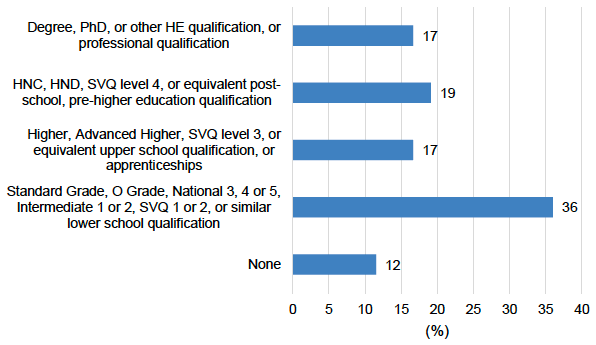Scottish Study of Early Learning and Childcare: Phase 1 Report - Updated 2021
Phase 1 of the Scottish Study of Early Learning and Childcare (SSELC) aimed to gather a robust baseline of child and parent outcomes for a cohort of eligible two-year-olds who were receiving 600 hours of funded early learning and childcare provision.
This document is part of a collection
Child, parent and household characteristics
Characteristics of the cohort
A little over half (53%) of those responding to the parent survey were single parents, while 47% lived in two parent households. The vast majority of children (91%) lived with at least one birth parent whilst 9% were looked after by a grandparent, foster parent or other carer (e.g. other relative). Twenty-eight percent of respondents had only one child aged under 16 living in the household (that is, the two-year-old child receiving the funded ELC provision was the only child in the household), while 39% had two children and 33% had three or more children aged under 16 living with them.
Half (49%) of the respondents to the parent survey were in households amongst those with lowest 10% (decile) of equivalised household incomes (having an annual income of less than £9701)[14]. A further 20% of respondents were in households with incomes in the second lowest decile (an annual income of at least £9701 but less than £13,929) and 13% had incomes in the third lowest decile (an annual income of at least £13,929 but less than £17,638). The remaining 19% of respondents lived in households with incomes in the 4th to 9th deciles. The disproportionate representation of lower income households amongst the cohort reflects the eligibility criteria for access to statutory funded provision of ELC for two-year-olds. These are households that are more likely to have a parent or carer in receipt of certain qualifying benefits (out of work benefits or income related benefits). Eligibility criteria for the two-year-old entitlement also includes looked after, kinship care or a child with an appointed guardian. The 19% of children who were living in households with incomes in the 4th to 9th deciles were likely to be receiving statutory funded ELC either because they are looked after or in care, or through local councils using their discretion to offer funded or subsidised ELC over and above the legal entitlement to provide support for a wider range of families.
The eligibility criteria are also reflected in the deprivation levels of the areas where respondents lived. Almost half (47%) of respondents lived in areas amongst the 20% most deprived in Scotland[15] with the remainder living in less deprived areas.
Figure 1 provides details of levels of education amongst parent respondents. As the graph shows, 17% had degree level qualifications and a further 19% had other post-school qualifications; 17% had Highers, Advanced Highers or equivalent, and 36% had Standard Grades or equivalent as their highest level of educational qualification. The remaining 12% had no formal qualifications. As would be expected, respondents living in higher income households (4th to 9th deciles) were more likely to have degree level qualifications. These figures suggest the cohort has lower levels of educational qualifications than parents of two-year-olds generally. For example, data from the Growing Up in Scotland study indicates that 42% of Scottish children aged 2-3 in 2013 lived with a parent who was degree-educated and only 5% had parents with no qualifications[16].
Figure 1: Highest level of education of respondent

Base: All respondents (parent survey)
Most respondents were white: 85% identified themselves as White Scottish, 7% as White Other British and 4% as Other White ethnicity. Just 4% were from a non-White background. This is broadly reflective of the Scottish population – for example, the 2011 census found 4% of the Scottish population to be from minority ethnic groups[17].
The vast majority of parents (91%) spoke only English at home, while 7% spoke English and other languages and 2% spoke only another language.
Contact
Email: socialresearch@gov.scot
There is a problem
Thanks for your feedback